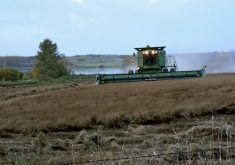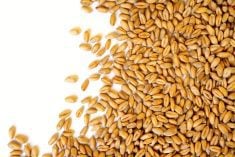WINNIPEG — This summer’s erratic weather has taken a toll on plant development in Alberta and parts of western Saskatchewan, according to reports from those areas.
“We have heard that dry conditions have caused plants (peas) to slough off or have the tillers dry off and have lost those heads,” said Barry Yaremcio, at the Ag Info Centre in Stettler, Alta.
“One guy was saying his neighbour got 12 to 15 bushels an acre and he was getting 21. So definitely we’re looking at below-average yields,” said Alberta crop specialist Harry Brook, who works out of the same office.
Read Also

Canadian trade data delayed by U.S. government shutdown
Canadian international trade data for September will be delayed indefinitely due to the ongoing partial shutdown of the United States government, Statistics Canada said Friday, Oct. 24.
So far, peas, fall rye, winter wheat and lentils have started to come off.
Yaremcio said the dry weather helped to speed up the harvest.
“Some guys are also swathing barley, the crop came along a lot faster because of the dry conditions; just matured quicker than normal.”
While rain the last few days of July and early August helped replenish many Alberta plants, Yaremcio said some crops didn’t make it.
“In the area that didn’t get the good rains the first part of August, lots of the crop is being cut for green feed or silage. Crop insurance is writing them off.”
The Pincher Creek area in southwestern Alberta is the one region he’s heard of that had great crops, but he points out they received 50-75 millimetres of moisture in late May and early June.
As for the rest of the province, Brook feels some of the later seeded crops may have an advantage over the earlier seeded ones due to timely rain.
In western Saskatchewan, farmers are encountering similar moisture issues, according to Norm Hall, president of the Agricultural Producers of Saskatchewan.
“Lentils in the southwest are about a third to two-thirds of normal while the winter wheat near Wynyard is a little bit below normal.”
While the western part of the province suffered from a lack of moisture, that’s not the case in areas east of Moose Jaw and Prince Albert.
“East of that and the crops are closer to average. In the northeast, there are reports of fantastic looking crops,” said Hall.
In fact, some eastern areas have had too much rain.
“But can’t get equipment out there, there’s too much water,” he said.














